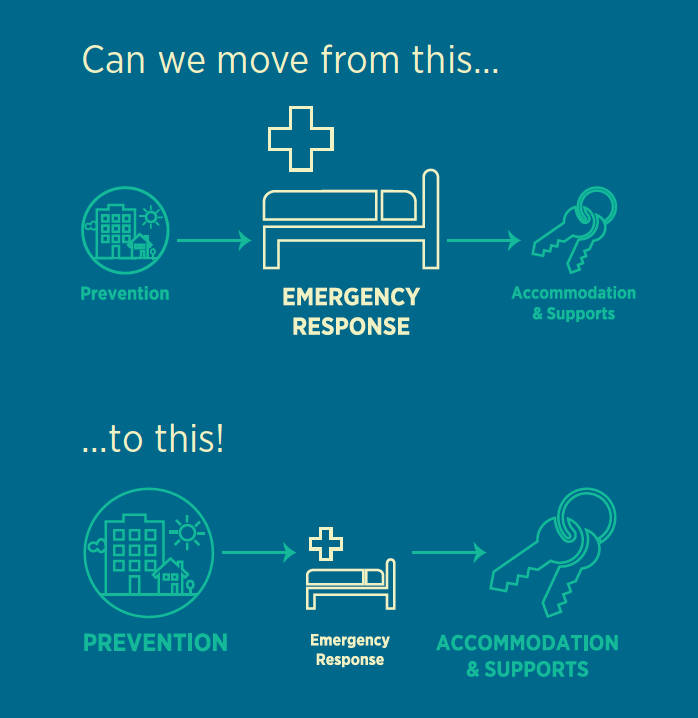There are three main ways you can address homelessness:
- Prevention – Stopping people from becoming homeless in the first place.
- Emergency Response – Providing emergency supports like shelter, food and day programs, while someone is experiencing homelessness.
- Housing, Accommodation, and Supports – Providing housing and ongoing supports to move people out of homelessness.

Since mass homelessness emerged in the mid-1980s, we have largely used emergency services to respond to people’s immediate needs. While we will always need emergency services to help those in crisis, over time these short-term responses have become the standard method for managing homelessness long-term.
In the last decade, Canadian policies and practices have begun to shift from managing homelessness to finding solutions, in particular the expansion of the Housing First approach across the country. The Housing First model provides housing and supports for people experiencing chronic homelessness with no housing readiness requirements. New research, innovation, and best practices have propelled our thinking to make the goal of ending homelessness achievable; however, we are still missing an important piece – preventing homelessness in the first place.
Why must we wait until people are entrenched in homelessness before offering help?
Evidence from Australia, Wales, England, the United States, and Canada reveals that homelessness prevention makes sense from social and economic perspectives. Evaluations of prevention initiatives in Germany and England have demonstrated that prevention contributed to the reduction of homelessness. A range of prevention interventions, from eviction prevention and support for survivors of intimate partner violence to landlord mediation, all showed success.
In Canada, research on the importance of discharge planning from correctional facilities, hospitals, and shelters provides evidence that prevention efforts can and will be successful in the Canadian context. Research continues to inform emerging practices to support key populations, including youth, veterans, families, and those with high needs such as addictions and mental health challenges. While there are some gaps in the knowledge on homelessness prevention, particularly as it relates to evaluation and measuring outcomes, the evidence is mounting that it is effective and worth investing in.
Defining Homelessness Prevention
There have been several efforts to define homelessness prevention in recent years. Simply put, homelessness prevention refers to policies, practices, and interventions that provide supports designed to:
- Reduce inflows into homelessness – in other words, stop people from becoming homeless in the first place.
- Reduce the risk that those who have recently become homeless experience long-term or chronic homelessness.
- Reduce the risk of returns to homelessness for those who have exited homelessness.
Preventing homelessness also requires recognizing that its causes are not the same for all groups.
Preventing homelessness means recognizing that its causes can vary across different groups, with Indigenous Peoples, racialized communities, 2SLGBTQ+ individuals, women, and youth having distinct experiences of homelessness.
For Indigenous Peoples, the impacts of historical and ongoing colonization, racism, and discrimination require distinct structural and systemic approaches to preventing Indigenous homelessness. As such, we must take a critical look at mainstream approaches to prevention and ensure they are broadened to meet the self-defined needs of Indigenous Peoples. Critically, Indigenous homelessness prevention must focus on recognizing rights to self-determination, reconnecting with and sovereignty over their homelands, fostering community, building links with Elders, and strengthening cultural identity.
To effectively prevent homelessness, we must have a clear understanding of what prevention entails and what it does not.
Emergency services that offer supportive measures intended to alleviate the negative effects of homelessness, such as nutritional and cooking programs or employment training and access to jobs, do not directly prevent homelessness. Therefore, it is important to differentiate between preventative measures and those that simply mitigate the effects of homelessness.
Related resources
- Journal
Towards the Prevention of Youth Homelessness
In the past, preventing youth homelessness hasn’t been a priority in Canada or the United States, but things are starting to change. More people now understand that preventing homelessness is...
- Report
The Case for Youth Homelessness and Homelessness Prevention in the UNECE Region
This brief aims to highlight the necessity for immediate and comprehensive action to address youth homelessness as a vital step toward achieving the objective of implementing the Geneva UN Charter...
- Report
Upstream Canada: An Early Intervention Strategy to Prevent Youth Homelessness & School Disengagement
Upstream Canada is a response to this challenge and the staggering reality that 35,000 – 45,000 youth in Canada experience homelessness each year (Gaetz, 2016). This initiative is a preventive...
Related Blog posts
-
Research
Preventing Homelessness in the United States: Evidence, Scaling, and What Works
In the past two years, the United States experienced a significant rise in homelessness, largely due to the migration crisis. Many individuals entered through the southern border, with Texas directing...
-
Interventions
Early Intervention and Prevention: How the COSS Model Shapes Australia’s Approach to Youth Homelessness
The Community of School and Services (COSS) has become a key player in homelessness policy discussions across Australia. This evidence-based approach aims to prevent youth homelessness by proactively identifying and supporting...
